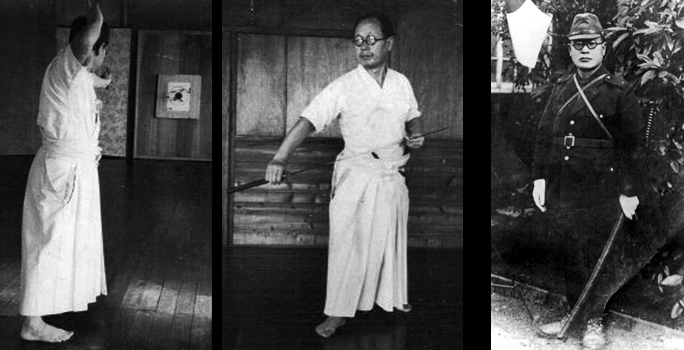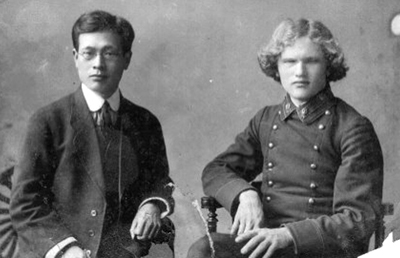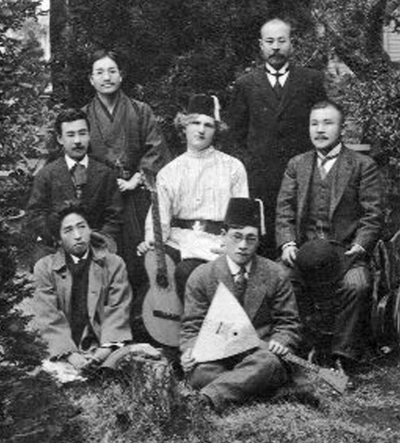Military Swords of
Imperial Japan
Evaluation of a Guntō
In the front of North China, the summary of the work "Japanese
sword to fight" of Mr. Kanji Naruse of the army civilian
employee who fixed Guntōes is introduced.
Hi is the Bushidō person of a Yamamoto style of the military
tactics which get across to the Kuwana han, and he is the expert of a
throwing knife.
He wrote the result of having stayed at the front of North China
for nine months, and having fixed 2,000 Guntōes in 1938 to the book
"the Japanese sword to fight.".
A part of the book is summarized and it introduces to below.
An author, Mr. Kanji Naruse
"Japanese sword to fight"
Although it was known well on the sword community and high
"Masamune" of evaluation had, it turned at the sword with the first one
blow.
The sword of Sōsyū(the country in Sagami) which makes Masamune
the originator has the common fault over which it passes
flexibly, and turned at every sword well. Masamune of a swordsmith
applied to Tokugawa Period from the middle of the Ashikaga age, was
alike among the public, and became famous.
In the back, a kind of privilege of manipulating political and
profit-making various means helped, and the name was intentionally made
high at it. It is the actual condition. Most noted swords known by the
world have tended to be respected as a work of art for appreciation
more than practicality.
I experienced that the "program of the ranking of right and
wrong" of the sword of the judge of a public sword was very
random to the actual condition of a battlefield, and felt it
thoroughly.
After all, I cannot have any longer the "belief" that the
specialist of a sword is fascinated.
I think that it is a mistake that the judge of the sword which is
in the domain of a fine-arts curio selects the propriety of the Guntō
with which a military man entrusts a life. The right sword and the
sword called a work thing mentioned the name not by selection by the
result of many battles but by trial cut of the government official who
cuts the head of the world of the peace of Tokugawa Period.
The sword is not necessarily useful to a battle immediately.
Its blade is pliant because a Ko-tō has many which were made into
the battle of the Warring States.
Work of the edge which the specialist of a sword says etc. does
not have any relation in a battle.
A sword required for a battle is "a pliant and powerful sword※".
There are many powerful swords also in a Shin-tō with pliant.
※ A powerful
sword does not mean a sword with a hard blade. Generally, the sword
after the Shin-tō
using a hard Tamahagane has a hard blade, and it is
weak.
Notes
of a writer:
Mr. Naruse esteems the Kotetsu paternity which
concentrated on the sword which can be fought, and he is criticizing
violently Mishina of the Shin-tō which inclined on the fine-arts sword
of the Edo period especially Kyōto and Osaka as having been
degenerated. Only the peaceful Edo period whose battle was lost, and
the blade beauty of a sword were praised, and the essence of a Japanese
sword was missed.
The Samurai was bureaucratized and the idea of a samurai's soul
in a sword was born.
This idea also faded gradually in the peaceful long world.
Swordsmiths concentrated on fawning for asking and making the gay sword
of a Hamon with gorgeous wealthy merchants who made the sword cherished
article and Samurai who have forgotten fighting. The peak of corruption
is the Genroku age of Edo.)
I have said one thing positively.
Consideration of a sword is unnecessary although the thing
installed and placed is cut.
A sword is good at an one-piece forging.
Commonly, the sword of a category called a Syōwa-tō has a simple
edge, and because it is hard, it cuts rather well depending on the
subject to cut.
Recently, a certain famous teacher cut the object in front of a
certain General using the sword of the one-piece forging which extended
and tempered Occidental iron. Since the teacher cut every object
splendidly, the General said, "It will be the Hizen-tō". I heard the
talk "the teacher who heard it was surprised".
January, this year (1938), a certain swordsmith cut steel using
this sword(Sunobe-tō) made from Western iron in the Department of the
Army.
Although there was no trouble in the edge of this sword, it broke
from the origin of an edge and this swordsmith got the grievous injury.
Since it was a long Tang with curvature when this sword is seen, it was
the appearance to which power gathers in the place of a Habaki
dynamically. And since a temper was strongly contained, this sword
broke.
If the form of a Tang was normal and the temper of the origin of
an edge had returned moderately, possibly this sword was mistaken for
the Hizen-tō like the front example.
Sergeant Kako of a Guntō repair group is an excellent swordsmith.
Since the operative of the forging factory in a unit did not have arms,
there was a request which makes a sword as an object for self-defense.
The old spring which is the useless article of a car was forged
roughly, and it was considered as the form of a sword.
Since full-scale hardening was not completed, it made the sword
from the same manufacturing process as "Zōhei-tō" which
puts a temper into the whole and is returned moderately.
Some swords are made in two - three days, it is polished with the
oil-filel, and it applies to a ready whetstone, and is considered as a
blacksmith's polish grade, and a Hilt(Tsuka), a Scabbard(Saya), and a
Scabbard-cover are made at the factory of the Guntō repair group, and
the factory of the saddle, anyway it enabled it to carry.
When cutting the thing to the trial, this sword cut the object
very well, so that it was surprised. Therefore, the nickname
"Ensyū-Kotetsu"※1
was attached automatically and this sword became famous.
It prospered, so that the Engineer Brigade borrowed the factory
of the blacksmith of China, collected all these springs
and made the sword.
The Ensyū-Kotetsu" became reputation by a Tsuura※2 railway
area-along-the-railway-line whole those days.
Self went out and the officer who disappeared and damaged the
Guntō asked for the forge of a sword.
I announced this thing both 3 times.
I am the standpoint of physics and considered practice and
maturity of this substance.
Therefore, the old iron which supported the heavy car for many
years changed to the flexible and hard thing that the quality ripes
unawares.
If a sword is the purpose only which "not distorted, not break
and can be cut well", this "Ensyū-Kotetsu" can be said to be the thing
near full marks.
Although this sword was used behind and about ten persons were
cut with the battle, there was no nicked edge and the edge was not
distorted. Although relics sword※3 which Sergeant Fujii forged himself at a certain
point in central part China was fairly fought by it, it did not look at
damage.
Since the situation of this sword thinks the Ensyū-Kotetsu and
the well-matched talk, it is added here.
※1 Ensyu=The name of
a Chinese state
※2 Point out the deployment position group of a Tsuura railway
area along the railway line
※3 From a situation, this sword is presumed to be a Sunobe-tō.
Since Sergeant Fujii was killed in war, this
sword is called "relics sword."

Mr. Kanji
Naruse which self-trains a throwing knife and Iai.
Gunto repair army civilian employee's era.
This book was published in 1940.
The performance as arms of a sword was proved for the first time
with a lot of swords in history by this book.
This book was written in public opinion with the absolute myth of
a Japanese sword under wartime suppression of freedom
of speech.
Although the author described the actual condition of the
Japanese sword in a battlefield frankly, he brought the result of
having criticized bitterly the myth of the Japanese sword of the
fine-arts sword unbalance which the sword community fabricated.
Most turned at the Japanese sword in the battle (probably, of
course, naturally, there was also an excellent Japanese sword), and
when the sword called a Syōwa-tō removed the deep exception of temperd,
there was no problem in a battle.
Although that a blade bends depends also on a user's ability,
most turned at the Japanese sword in the battle (probably, of course,
naturally, there was also an excellent Japanese sword), and when the
sword called a Syōwa-tō removed the deep exception of a harden, there
was no problem in a battle.
The actual condition of a Japanese sword and a Syōwa-tō is
explained in full detail by the companion volume to this book
"Jissen-Tō-Tan (An Account of the Sword of a Battle)※".
These two books are the only precious data which verified the
real image of a Japanese sword and a Guntō.
Much Japanese sword data published at the present have only
quoted the data fabricated at the Edo period.
A present-day sword community has continued disregarding such
precious actual proof record.
They have played with an impracticable theory without verifying
the truth for about 100 years, with the "original text"
accepted without question.
A present age sword community cannot avoid neglectful criticism.
Or it seems to have a political and profit-making intention.
Mr. Naruse has concluded that the rank of judgment of an Edo term
is intentional and political based on battle verification of the
Japanese sword in a battlefield.
These books teach us the new concept of a Japanese sword.
※ Although the contents of this book are stated to another
section in detail, it has not translated into English yet.
Impressions of a Japanese
sword
The starting point of a Japanese sword is arms.
The technology of grinding appeared in the Ashikaga age(AC.14-16)
and the art of a Japanese sword has been recognized.
Even if there is art, it cannot have the sense of reverence in a
sword vulnerable as arms.
The trend to make light of and despise except the Japanese sword
for divine-ornaments appreciation is just putting the
cart before the horse.
Originally Japanese swords are not accessories.
If only the beauty of Hamon and grain is a noted sword, a better
thing should be made with the imitation sword of advanced technology.
It seems that the standard of value of the Japanese sword in a
sword community has separated from the starting point for a while the
past and now. The fall was unexpectedly exposed by Mr. Naruse.
The catchphrase of "not distorted, not break and can be cut well"
of the golden rule of a Japanese sword, is exceeded by Guntōes of
practical use, such as a Sunobe-tō and a spring-tō upon which the sword
community was frowning also to irony,
The persons involved in that time of Seki-shi are also doing the
same testimony as this.
Today's sword community is overemphasized in appreciation and
judgment, and the performance of the bottom of a sword
is intently devoted to the way of an "artistic handicraft article",
while it has been forgotten by it.
Therefore, on the other hand, the fabrication, the superstition,
and the myth about the arms performance of a Japanese sword are
audaciously rampant. It is also continued as arms not to use the sword
which turned into real ceremonial arms by the policy of "Enbu (arms are
dedicated)" of the Edo Shogunate by any means.
It is an opinion since that is right, that arms performance is
not a problem, to a Japanese sword, it is too impolite and it can be
said that it is one-sided, considering the starting point of a sword.
The basic requirements for a Japanese sword which collected
racial reverence from ancient times were the outstanding arms
performances.
This is a fact without complications also from the concept of a
fine-arts sword not having existed, either until the work of polish
progresses.
Since it was no longer used for the end of the Age of Civil Wars
(the swords were not already the main arms), and "the world of an Edo
peace" in a battle, improvement of a Japanese sword stagnated.
It is an unavoidable thing.
Though that is right, I think that I should reflect upon what a
true Japanese sword is.
Mr.Kanji Naruse of the young day as a
literary man

↑ Together with poet Eroshenko of the blindness
of Russia.
Mr.Naruse has a typical stringed
instrument balalaika of Russia. →
The face of a different literary man from a martial art house is known
with this photograph.
Yumeji Takehisa(front row left) representing the Taisho romance,
Mr. Kanji Naruse
(front row right), and a center are Eroshenko. → |

|
(Photograph offer: Mr. Yasuo Kamata (The professor of
the Kwansei Gakuin University comprehensive policy faculty,
Hi is the grandchild of the Mr. Kanji Naruse)
Since
November 28, 2013 
To
the top of a page ▲



